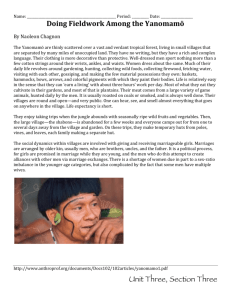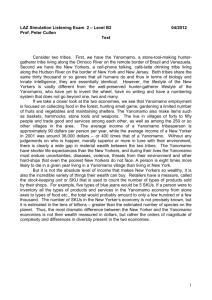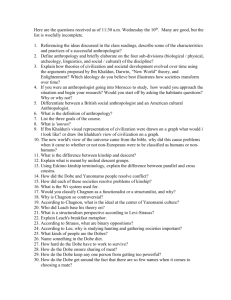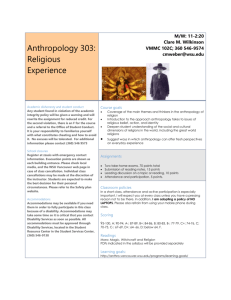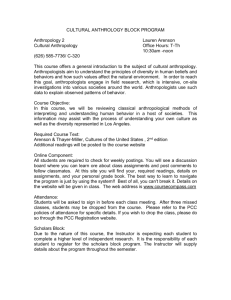SOCIAL ANTHROPOLOGY
advertisement
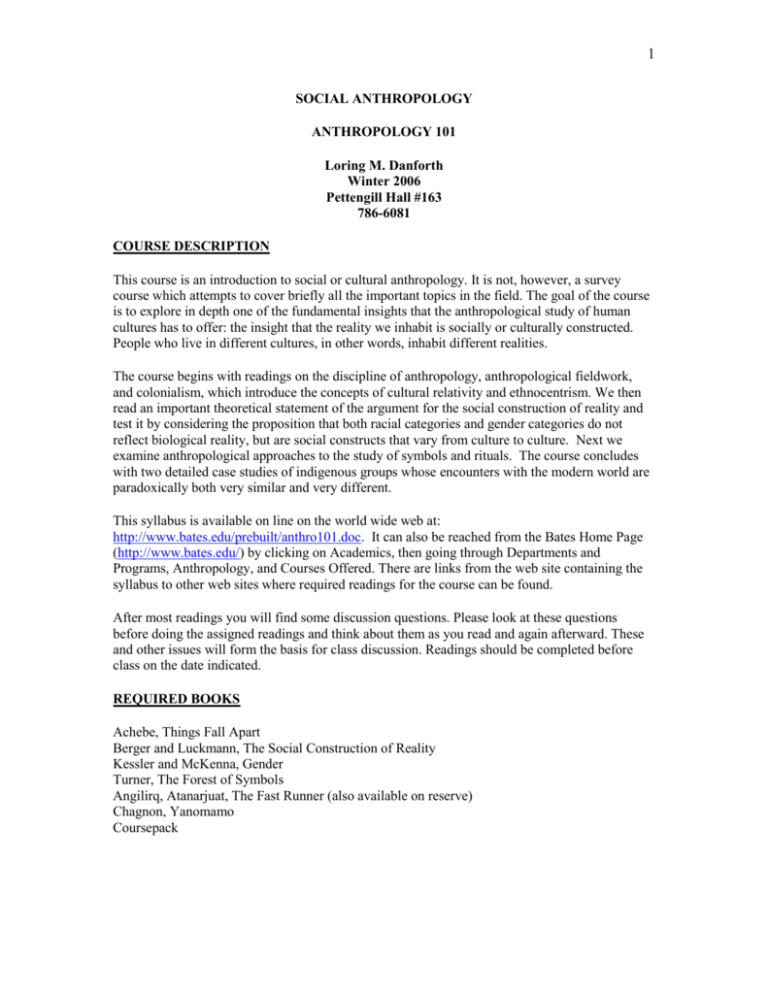
1 SOCIAL ANTHROPOLOGY ANTHROPOLOGY 101 Loring M. Danforth Winter 2006 Pettengill Hall #163 786-6081 COURSE DESCRIPTION This course is an introduction to social or cultural anthropology. It is not, however, a survey course which attempts to cover briefly all the important topics in the field. The goal of the course is to explore in depth one of the fundamental insights that the anthropological study of human cultures has to offer: the insight that the reality we inhabit is socially or culturally constructed. People who live in different cultures, in other words, inhabit different realities. The course begins with readings on the discipline of anthropology, anthropological fieldwork, and colonialism, which introduce the concepts of cultural relativity and ethnocentrism. We then read an important theoretical statement of the argument for the social construction of reality and test it by considering the proposition that both racial categories and gender categories do not reflect biological reality, but are social constructs that vary from culture to culture. Next we examine anthropological approaches to the study of symbols and rituals. The course concludes with two detailed case studies of indigenous groups whose encounters with the modern world are paradoxically both very similar and very different. This syllabus is available on line on the world wide web at: http://www.bates.edu/prebuilt/anthro101.doc. It can also be reached from the Bates Home Page (http://www.bates.edu/) by clicking on Academics, then going through Departments and Programs, Anthropology, and Courses Offered. There are links from the web site containing the syllabus to other web sites where required readings for the course can be found. After most readings you will find some discussion questions. Please look at these questions before doing the assigned readings and think about them as you read and again afterward. These and other issues will form the basis for class discussion. Readings should be completed before class on the date indicated. REQUIRED BOOKS Achebe, Things Fall Apart Berger and Luckmann, The Social Construction of Reality Kessler and McKenna, Gender Turner, The Forest of Symbols Angilirq, Atanarjuat, The Fast Runner (also available on reserve) Chagnon, Yanomamo Coursepack 2 RESERVE READINGS, LADD LIBRARY Angilirq, Atanarjuat, The Fast Runner (also available on reserve) Bloom, "The Body Lies" Hicks & White: “Nunavut: Innuit Self Determination” Molnar, Human Variation, Ch. 1 Packet of Readings on "Race and Ethnicity" Spradley & McCurdy, Conformity & Counflict Student Papers by Haskell, Lewin & McClain This We Believe Tierney, "The Fierce Anthropologist" Yanomamo Interactive, CD-Rom TOPICS AND READINGS January 4 Organization of the Course 1. ANTHROPOLOGY AS A FIELD AND AS A PROFESSION January 6 "What is Anthropology" and "Careers in Anthropology" Both are available in the course pack and on the world wide web at: http://www.aaanet.org/anthbroc.htm and http://www.aaanet.org/careersbroch.htm Video: Anthropologists at Work: Careers Making a Difference Browse the American Anthropological Assoc. home page at: http://www.aaanet.org/ Why is it important to study other cultures? What are some of the skills anthropologists develop? How could an anthropologist make Bates a better place to live and work? 2. THE NATURE OF ANTHROPOLOGICAL INQUIRY: CULTURAL RELATIVITY, ETHNOCENTRISM, AND THE CONCEPT OF CULTURE January 9 Bohannan, "Shakespeare in the Bush." Course pack. Miner, "Body Ritual Among the Nacirema." Course pack. Why is the Bohannan article humorous? Is Bohannan's position anthropologically sound? Is the Tiv's? Does Hamlet have the same meaning for the Tiv and for Bohannan? What does it mean to say anthropologists are engaged in "cultural translation"? 3 Can you translate "ghost" into the language of the Tiv? What is your reaction to the Nacirema and their culture? Does Miner's analysis of Nacirema body rituals constitute good anthropology? How do you think the Nacirema themselves would react to Miner's analysis? January 11 Achebe, Things Fall Apart, pp. 3-109. Is Things Fall Apart fiction or non-fiction? Does it matter? Is Things Fall Apart an account of an insider or an outsider with respect to Ibo culture? Whose account would be more objective? What do we learn about gender roles in Ibo culture from Things Fall Apart? How can you make sense of Ibo practices such as the oracle, Ezinma's case; and rain making? Is this magic, superstition, or religion? January 13 Achebe, pp. 110-209. Can Ibo gods harm people? Why do "Things Fall Apart?" Could the tragic events portrayed here have been avoided? How? What role does anthropology have to play in such situations? Who converts to Christianity? Why? January 16 Martin Luther King, Jr., Day January 18 Discussion Websites: Fact Sheet on the Ogoni Struggle http://www.ratical.org/corporations/OgoniFactS.html Ken Saro-Wiwa http://www.remembersarowiwa.com/ Shell Nigeria http://www.shellnigeria.com/ 3. THE SOCIAL CONSTRUCTION OF REALITY January 20 4 Berger and Luckmann, The Social Construction of Reality, pp. 1-53. What is the nature of everyday reality? What is the relationship between objective and subjective reality? What is the role of language in the social construction of reality? Are we "prisoners" of the language we speak? What is the difference between the way beavers and human beings build dams? Is there such a thing as human nature? If so, what is it? What is the relationship between biological factors (nature) and cultural factors (nurture) in human social life? January 23 Berger and Luckmann, pp. 53-128. What is the difference between objectification and reification? What are some examples of institutionalization? How are the following relationships legitimated in American culture: 1. 2. 3. 4. 5. The relationship between a 10 year old child and the adult male living with the child? The relationship between a 40 year old person and the person he or she is "living with?" Relationships between humans and animals? Relationships between men and women? Relationships between the "races"? 4. THE SOCIAL CONSTRUCTION OF "RACE" January 25 Before reading the assignment, write down answers to these questions: How many races exist? Name them. What is the definition of "race"? Molnar, Human Variation, Chapter 1, "Racial Variation and the Perception of Human Differences." Reserve. After reading the assignment, write down answers to these questions: Do races exist? What exactly does that mean? What is the definition of "race"? Additional questions for discussion: How do humans vary biologically? What is the difference between a "race" and an ethnic group? 5 What is the difference between a "race" and a breeding population? What is the relationship between everyday common sense, or "folk" categories and scientific categories? What does it mean to say "races" exist? How do "races" exist? Are you a racist if you classify people into races or if you believe races exist? January 27 Brace, "A Four Letter Word Called 'Race." Course pack. January 30 Packet of Readings on "Race" and Ethnicity. Reserve. "Revisions to the Standards for the Classification of Federal Data on Race and Ethnicity." Course pack. Are the categories used in the U.S. for census or affirmative action purposes "scientifically valid"? Should they be changed? Why? How? What is the difference between a "race" and an ethnic group? Are Hispanics a "race" or an ethnic group? How does reading about "racial" categories in South Africa change your view on the existence of races? Do you think a person can change "race"? How do you determine a person's "race"? Is "descent" or "appearance" more important? 5. THE SOCIAL CONSTRUCTION OF GENDER February 1 Evening Film: The Crying Game Kessler and McKenna, Gender, Preface and Chapters 1 and 2. Reserve. "Race" and "sex" (or "gender") are both categories we assign people to. What are the similarities and differences between these two categories? Do "sexes" or "genders" exist? How many are there? How do you determine a person's "sex" or "gender"? According to Kessler and McKenna, what is the difference between a person's gender attribution, gender assignment, gender identity, and gender role? How would you translate berdache into English? If you were an anthropologist studying the berdache, what questions would you ask to learn about it? February 3 Kessler and McKenna, Chapters 3 and 5. 6 What is the relationship between biological and cultural factors in shaping various aspects of a persons gender (identity, role, attribution)? Can a person change "sex" or "gender"? What happens when a person's gender identity and gender assignment conflict? What does it mean to say we are all "passing" as males or females? How does the study of transsexuals or intersexuals change the way you think about gender? February 6 Kessler and McKenna, Chapter 6 and Appendix. Bloom, The Body Lies. Reserve. Websites: The Room for the Wrongly Gender Assigned http://www.gn.apc.org/inquirer/gender_intro.html Intersex Society of North America http://www.isna.org/ Medical Treatment of Hermaphroditism http://www.gn.apc.org/inquirer/intersex.html Press for Change http://www.pfc.org.uk/ February 8 Discussion 6. RITUAL AND SYMBOLISM February 10 Turner, Forest of Symbols, Chapters I and II. What does the milk tree mean to the Ndembu? How do symbols convey meaning? Who decides what symbols mean, the anthropologist or members of the culture the anthropologist is studying? Can symbols have unconscious meanings? If so, how can anthropologists study them? What does the song Puff the Magic Dragon mean? Puff the Magic Dragon Puff the Magic Dragon lived by the sea and frolicked in the autumn mist in a land called Honahlee. 7 Little Jackie Paper loved that rascal Puff and brought him strings and ceiling wax and other fancy stuff. Together they would travel on a boat with billowed sail. Jackie kept a lookout perched on Puff's gigantic tail. Noble kings and princes would bow when ere they came. Pirate ships would lower their flag when Puff roared out his name. A dragon lives forever, but not so little boys. Painted wings and giant strings make way for other toys. One gray night it happened. Jackie Paper came no more, and Puff that mighty dragon, he ceased his fearless roar. His head was bent in sorrow. Green scales fell like rain Puff no longer went to play along the cherry lane. Without his lifelong friend Puff could not be brave. So Puff that might dragon sadly slipped into his cave. Is the meaning of a text determined by the intention of the author or the interpretation of the reader? Can a person engage in sexual harassment without intending to? February 13 This We Believe. This We Live. The Baltimore Catechism, "The Eucharist." Lessons 26 - 28. Course pack. Website: Inexplicable Eucharistic Phenomena http://members.aol.com/bjw1106/euchmir.htm What does the sacrament of the Eucharist mean? Why do Christians take communion? How would you respond to an anthropologist who interpreted the Eucharist as an example of both cannibalism and human sacrifice? Would this be a good interpretation of the rite? Analyze the Eucharistic miracles described on the web site. February 13 Evening Film: Walt Disney's Snow White February 15 Turner, Chapter III. Magoun and Krappe, The Grimm's German Folktales, "Snow White." Course pack. Sexton, "Snow White." Course pack. What do the colors black, white, and red mean to the Ndembu? Are they universal symbols? Why? 8 What do black, white and red mean in Snow White? What do we learn about American and European attitudes toward women and sexuality from the analysis of Snow White? How is Disney's version of Snow White different from the Grimm's version? Can you explain these differences? February 17 FIRST SHORT PAPER DUE Turner, Chapter IV. 3 short readings on hazing by Bushweller, Sorrell and Alfred University. Course pack. Kovic, Born on the Fourth of July, pp. 63-79. Course pack. Videos: Haze Days ESPN Outside the Lines: Hazing What are the component parts of a rite of passage? How do rites of passage work? What do they do? How can liminal things be disgusting and sacred? Think about the effectiveness of rites of passage you have witnessed or participated in. What is the distinction between initiation and hazing? Which category does Basic Training in the Marines belong to? Why? February 27 Discussion 7. FILM, CULTURE, AND POLITICS AMONG THE INUIT OF THE CANADIAN ARCTIC February 27 Evening Film: Antarjuat: The Fast Runner March 1 Rigby, MacDonald, and Otak. “The Inuit of Nunavut, Canada,” in Endangered Peoples of the Arctic, Freeman, ed., pp. 93-103. Coursepack. Matthiasson, Living on the Land, pp. 24-90. Coursepack. March 3 Hichs and White, “Nunavut: Inuit Self-determination Through a Land Claim and Public Government.” In Nunavut: Inuit Regain Control of their Lands and their Lives. Dahl, Hicks, and Tull eds. pp. 30-115. Reserve. Rigby MacDonald, and Otak, pp. 103-111. Coursepack. 9 March 6 Angilirq, Atanarjuat, The Fast Runner, Ethnographic Commentary. pp. 196-237. Angilirq, Atanarjuat, The Fast Runner, Screenplay. pp. 29-193. March 6 Evening Film: Atanarjuat, The Fast Runner, (Second Viewing) March 8 Angilirg, Atanarjuat, The Fast Runner, pp. 7-27. American Anthropologist, “Atanarjuat, The Fast Runner In Focus.” pp. 820-838. Coursepack. March 10 SECOND PAPER DUE Discussion. 8. KINSHIP, VIOLENCE, AND THE POLITICS OF REPRESENTATION: THE YANOMAMO OF THE AMAZON BASIN March 13 Chagnon, Yanomamo, Forward, Preface, Prologue and Chapter 1, pp. v-43. In Class Film: A Man Called "Bee": Studying the Yanomamo What image does The Man Called "Bee" present of the anthropologist? Are the Yanomamo similar to or different from Americans? Does the film emphasize the similarities or the differences? Are the Yanomamo "naked"? What are the power relationships established by the film between Chagnon, the Yanomamo, and students in this course? Comment on the film's claim that "when we look at the Yanomamo we see a glimpse into our past. We see ourselves several times removed, but ourselves nonetheless." Comment on the films claim that teaching skills in war is the most important skill for the Yanomamo as a sovereign people to pass on to their children. March 15 Chagnon, Chapter 2, pp. 45-97. 10 March 17 Chagnon, Chapter 8, pp. 227-260. In Class Film: Contact: Yanomamo of Brazil Compare this film to The Man Called "Bee". How does it change your perception of the Yanomamo? Are the Yanomamo a sovereign people? What can be done to keep "Things From Falling Apart" for the Yanomamo as they did for the Ibo? March 20 "Correspondence." Course pack. "Forward to Fourth Edition." Course pack. Tierney, "The Fierce Anthropologist," New Yorker, October 9, 2000. Reserve. Websites: Yanomamo People Face Risks http://www.aaanet.org/press/pryano1212.htm AAA and Human Rights http://www.aaanet/edff/index.htm./ Whose side do you take in the dispute between Carneiro da Cunha and Chagnon? Why? Is Chagnon responsible for the mass media's sensationalization of his work? Are the Yanomamo a "Fierce People"? Was Chagnon right to have eliminated the subtitle "The Fierce People" from his book? Do you believe Tierney's charges against Chagnon? Why? March 22 Chagnon, Chapter 3, 4, and 5, pp. 99-183. Websites: Kinship and Social Organization: An Interactive Tutorial http://www.umanitoba.ca/faculties/arts/anthropology/kintitle.html Yanomamo Kinship htpp://www.umanitoba.ca/faculties/arts/anthropology/tutor/case_studies/yanomamo What are the basic principles of the Yanomamo kinship system? Who can a Yanomamo marry? What is the relationship between kinship and biology? 11 March 24 Discussion March 27 In Class Film: The Axe Fight Chagnon, Chapter 6 and 7 pp. 185-226. Yanomamo Interactive: The Axe Fight (on CD-ROM) What is the relationship between kinship and politics in Yanomamo culture? In political conflicts, how do Yanomamo decide which side to take? Why do Yanomamo in one village trade with Yanomamo in another village? March 29 Discussion March 31 Discussion April 3 Discussion COURSE REQUIREMENTS 1. Class attendance and participation in class discussion. Regular and valuable contribution to class discussion will raise a student's grade. Poor attendance will lower it. 2. Two short papers based on the readings, 3-5 pages in length. 3. Take home final examination. SCHEDULE OF DUE DATES Late papers will be graded down unless an extension has been granted. February 17, FIRST SHORT PAPER March 10, SECOND SHORT PAPER April 7, TAKE HOME EXAMINATION (Handed out April 3). SHORT PAPERS The first short paper should deal with the readings on "race," Gender by Kessler and McKenna, or The Social Construction of Reality by Berger and Luckmann. The second paper should deal with Turner's The Forest of Symbols. For these short papers, students may choose to write a critical 12 review of the assigned readings. This should not be a book report summarizing the reading, but an original analytical comment on, or a reaction to, a major point in one of the readings. Most students, however, choose to write another kind of paper, a paper in which they apply one of the interpretive approaches presented in the assigned readings to some phenomenon of their own culture that they are familiar with from their own personal experience. The goal of this type of paper is for students to use an anthropological theory or method of analysis to discover something new and interesting about an aspect of their own culture that they could not have discovered without the benefit of the anthropological readings from the course. It is essential that students state clearly and thoroughly the theoretical perspective they are using in their paper. Students should avoid summarizing, describing, and stating the obvious. They should get beneath the surface of things and offer an interpretation of what the ritual, institution, social relationship, fairy tale, or television show means. Several classes (including those on The Crying Game, the Eucharist, Snow White, basic training, and childbirth in the US) will be devoted to just such projects. There are several examples of good student papers on reserve for you to consult while preparing your own paper. Here is a sample outline for the short paper assignment: I. Introduction (one paragraph) II. Theoretical approach (one page) III. Ethnographic description (one page) Analysis, in which the theoretical approach is applied in order to interpret the IV. ethnographic data (two pages) V. Conclusion (one paragraph) PLEASE NOTE: 1. All students are responsible for reading and understanding the Bates College Statement on Academic Honesty. If you have any doubts or questions about what constitutes plagiarism, please see me. 2. Please bring your copy of the assigned readings to class. Readings should be completed before class on the date indicated. 3. There will be several evening film screenings. Attendance is required. 4. Your fellow students and I would appreciate it very much if you arrive in class on time, refrain from getting up and leaving the room during the class hour, and turn off your cell phone. Thank you.
